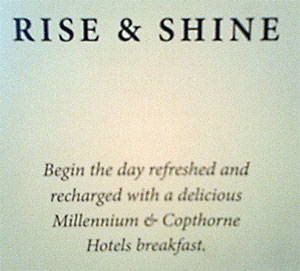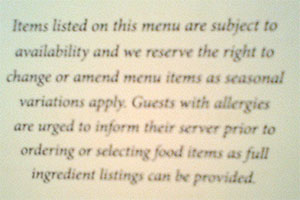Plain English Patrol 3
Recently, I stayed at the Millennium Madejski Hotel in Reading. (It’s handy for Legoland.) I have a secret liking for ultrabeige artificial environments like that, so I was happy enough – until I began idly browsing the menu over breakfast. The front read as follows:
Rise & Shine
Begin the day refreshed and recharged with a delicious Millennium & Copthorne Hotels breakfast.
Not spectacular, but I can’t really argue with it. It totally does the job for the brand, the situation and the audience, and I’m sure I would have written something very similar.
On the back of the same menu, however, the tone of voice takes an abrupt left turn:
Items listed on this menu are subject to availability and we reserve the right to change or amend menu items as seasonal variations apply. Guests with allergies are urged to inform their server prior to ordering or selecting food items as full ingredient listings can be provided.
We’re used to seeing different tones of voice for different purposes or situations. After all, real people vary their tone all the time – the tone I take when meeting a client in their office will devolve dramatically if we go out for a drink later on.
And when writing for a brand, it’s completely natural to strike a different tone in ‘selling’ and ‘official’ content – a good example being the contrast between a website’s home page and its terms and conditions.
However, the variation in our desired tone of voice may not map neatly on to the different elements of the customer’s experience. It may be that things we see as separate, or want to treat in different ways, are closely related in terms of user experience, purchase cycle or brand touchpoints.
For example, the hotel guest may be pleased to learn that the breakfast will refresh and recharge them, but immediately anxious for reassurance about their nut allergy. For them, the whole value proposition hinges on the small-print stuff.
If we vary the tone too sharply between areas that are closely linked for readers, we may implicitly undermine trust and what NLP practitioners call congruence. In human terms, our text steps over the line that divides ‘smooth-faced’ from ‘two-faced’.
In my view, this menu is a case in point. It’s all smiles when it wants your money, but when it comes to what’s actually offered in return, it retreats into multisyllabic, passive-case formality. And these two tones are, quite literally, found on the two ‘faces’ of the printed format.
This is a classic instance of language as defence mechanism; of speaking without wanting to communicate. The officious bureaucrat erects spiky word barriers around accountability and commitment that few readers will want to negotiate (or be able to). Sadly, it’s an approach that gets used far too often, particularly in the public sector.
Behind the bluster, the actual message is usually quite simple. Here’s a rewrite of the back-of-menu text:
Some foods aren’t always available. Please tell us if you have a food allergy; we can give you a full list of ingredients.
This reduces the reading age from the original’s 17 down to eight, greatly enhancing the odds that allergy sufferers will actually get the message they need to hear.
My version also makes it much clearer that the menu isn’t a promise – and it’s probably this clarity of obligation that makes people shy away from a simple, straightforward tone. Or maybe it feels like a simple tone just isn’t ‘hard’ or ‘important’ enough. But once you start reaching for the big words, you usually end up with a sledgehammer to crack a nut.
I’m not saying that everything should be written in exactly the same tone, regardless of its purpose. Instead, the tone should be as consistent as it can be, while still moving with the audience’s needs. We should write how people want to read.
Comments (17)
Comments are closed.


The menu is a good illustration of an important point. Consistent tone is ideal but as you say it has to be varied occasionally. If you have to vary it, just don’t make it so obvious.
Is there evidence that readers notice such differences and, if so, behave differently as a result?
[…] Plain English Patrol 3 […]
Great point. Also, to me, it reads less like ‘we care that you have a good experience/don’t die from your nut allergy’ and more like ‘we’re putting this here to cover our arses should you wish to register a complaint’.
I like your version better.
This menu get-out clause sounds legalese. Lawyers insist companies put this stuff in to protect themselves. It’s the price we pay for living in litigious times.
Maybe the copywriter wrote something like your suggestion, Tom. But the lawyers won and used the get-out clause instead. Such is life.
@Paul D
I don’t know. In this case, I find it hard to imagine an objective test where the format would not prejudice the result. Any ‘evidence’ could only be based on questions such as ‘what did you think about this text?’ or ‘how did you act as a result?’. Since everyone denies acting on advertising, but adverts clearly drive sales, I’m not sure such a venture would get very far. The best we can do is look at consumers’ autonomous behaviour and tentatively ascribe some aspects of it to the actions of marketers or writers.
We can also be fairly sure, intuitively and anecdotally, that text that is shorter, with simpler sentence structure and less obscure language, is more likely to be widely understood than long, convoluted text with unusual word choices. Again, gauging ‘understanding’ is difficult, but if we look at the cultural artefacts that are most widely and enduringly popular, or the marketing that is most successful, I think it is likely that they would share these attributes.
@Paul E
A very good point, and one I’ve been pulled up on before. So let me make clear that I’m criticising the product, not the producer. I’m not having a pop at a fellow copywriter, nor even the lawyers who may well have insisted their words had to change. I’m simply analysing the work as published.
Thanks, Tom. You write: “We can also be fairly sure, intuitively and anecdotally, that text that is shorter, with simpler sentence structure and less obscure language, is more likely to be widely understood than long, convoluted text with unusual word choices.” I agree with those assumptions, but the style-guides differ on their implementations. It’d therefore be good to test whether, for example, passives always make comprehension harder. One can, indeed, test comprehension and/or behaviour. Social science does it all the time.
I began my career as a technical author, and one of the things that was drummed into us at uni was to avoid the passive voice. There were lots of rather tedious lectures on comprehension etc., and what it boils down to is yes, the passive voice has less effect on the reader (as you’d expect).
Interestingly, one of the reasons the passive voice is shunned in lots of user documentation these days is because of litigation – if instructions are passive, it can become unclear as to who is required to do what, especially where certain actions can be performed automatically, while others require user interaction.
The same warning could (and should) have been written in a friendlier tone that would have communicated the same information without having a negative impact. Why would anyone listen to lawyers about wording when their entire industry is rife with baffling jargon and awkward English? Say the same thing in clearer words = better communication and your arse is still covered legally.
“was drummed into us” “the passive voice is shunned” “who is required” “actions can be performed” “The same warning could (and should) have been written”? Lol.
Mightn’t the passive sometimes be used to avoid litigation?
Yeah, but I was writing about the past then, so it is okay!
There could be some instances where the passive helps to avoid litigation…can’t think of any off the top of my head though.
Hi, yet “the passive voice is shunned” “who is required” and “actions can be performed” are present. Are you saying you were told passives were OK in the past?
“The passive voice is shunned” – is present. The trend in many industries now is to avoid the passive voice for user documentation.
I was taught not to use passives in user documentation in the late 1990s. Back then, a lot of user documentation used passive, formal copy. These days, it is far more common to only see present tense in user documentation because it is clearer and because of litigation. Past tense is normally only used when describing events that occurred previously, such as ‘the option you selected in step 3’.
Happy now? 🙂
When you say passive, do you mean past tense?
Sorry, I wandered into past tense territory, yes. I’m having a brain-dead afternoon.
Bottom line – I can’t think of any decent reason to use passive voice in marketing/information unless you want to create that detached, cold corporate feel. And there is research somewhere about why it is less effective as communication (but I don’t recall who conducted the research).
Understood. “Passives are avoided” is present and passive. Passives have few fans, except the US government which likes them for when the law is the agent, you the patient!
Ready for duty on the Plain English Patrol, Tom! I don’t see why anything shouldn’t be written in plain English – why make copy hard for the reader to understand? #copywritersunite
Great post four years ago and still great today. It’s a helpful reminder as I work on various pieces of copy for our app. We want to carry our brand voice throughout but sometimes there’s just some down and dirty info that needs to be communicated straight up. Keeping it straight up is the goal. Thanks for this.